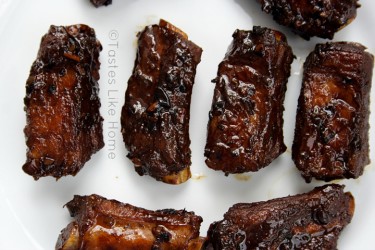Hi Everyone, This week I conclude the 2-part series looking at cooking with pressure cookers.
Last week I told you that I have a new pressure cooker – a Futura – from the Hawkins line of pressure cookers. I have used it several times since I purchased it, to cook a variety of things – rice, soup, pork chops, green plantains, a roast, cook-up rice and a couple of other things. My aim was to test it by making things that I’d usually cook in my other Hawkins pressure cookers to compare how the hard-anodized Futura performs.
The following are my findings:
● The Futura heats up quickly and thus comes up to pressure faster.
● The hissing sound when it’s at full pressure is not as forceful sounding as the others with the knob-like vent weights. The hiss is constant, pulsating and never gives off that sudden burst of intermittent steam as some cookers do.
● Very easy to close and open.
● It takes less time to release the pressure in order to open the cooker.
● The cooker is very light and not heavy. This is excellent, especially for people with arthritic hands who can find it difficult to lift heavy pots and pans.
 ● The cook time fluctuated. A review of the recipe books for the standard regular Hawkins and the Futura indicates the same amount of cooking time for the recipes provided but I found that to be only marginally true in some cases. Of course food quantity, size of cooker and the type of energy being used (gas, electric, induction) all contribute to time fluctuation when cooking. However, I would still recommend that you be guided by the timing indicated in the recipe. When you check your food for doneness, if it is not to your liking, cook it a minute or two longer. For example, when I cooked rice in the pressure cooker – Basmati, with the amount of water and time indicated, the rice was not cooked to my liking, I found it hard so I pressured it for an additional 3 minutes. It is not to say that the rice was in any way inedible; it just was not to done to the degree of tenderness that I prefer my rice. As with all cooking – adjust to suit your taste.
● The cook time fluctuated. A review of the recipe books for the standard regular Hawkins and the Futura indicates the same amount of cooking time for the recipes provided but I found that to be only marginally true in some cases. Of course food quantity, size of cooker and the type of energy being used (gas, electric, induction) all contribute to time fluctuation when cooking. However, I would still recommend that you be guided by the timing indicated in the recipe. When you check your food for doneness, if it is not to your liking, cook it a minute or two longer. For example, when I cooked rice in the pressure cooker – Basmati, with the amount of water and time indicated, the rice was not cooked to my liking, I found it hard so I pressured it for an additional 3 minutes. It is not to say that the rice was in any way inedible; it just was not to done to the degree of tenderness that I prefer my rice. As with all cooking – adjust to suit your taste.
● Clean up is easy and almost no scrubbing involved. Stuck on bits came off easily with hot soapy water and a brush.
● The handle stays cool even though the cooker is on the heat for an extended period of time.
● One of my favourite features is that when releasing the steam – it is done pointing away from you! I’ve had unwanted facials with my other cookers.
It goes without saying that I love my new pressure cooker and I look forward to using it for many, many years to come.
The benefits of
pressure cooking
In one of my columns last year, I told you about the ladies standing in line at immigration (in Barbados) discussing food and how they cook. As a quick refresher: there was one woman in the trio who was the guiding force of the conversation (there always is, isn’t there?). She was telling the others that these days she cooks everything in the pressure cooker; that she is out of the kitchen in no time because the food cooks up quickly, and in the final push to drive home her point, she spoke of the money she saves on energy, in her case, gas.
She was right, on every point.
● Cooking with a pressure cooker significantly cuts down on cooking time, hence the food is finished relatively quickly and that means you spend less time in the kitchen.
● It is a very healthy way of cooking as you are cooking with steam and a pressure cooker provides easily for steamers, single and stacked to be inserted into the cooker and be done cooking in almost no time. Cooking with steam allows food to retain most of its nutrients.
● It saves energy whether you are using gas or electricity due to the fast cook-times.
● It saves money in two ways. First the savings from your energy bill and secondly, a pressure cooker allows for less expensive cuts of meat that can be tougher (though they are more flavourful) to become so tender that they literally fall-off-the-bone and can be cut with a spoon.
● Pressure cookers are not only for curries, soups and stews, one can sauté, sear and steam too. A pressure cooker makes quick work of a pot roast.
● If you’re after char and crust on your roast, cook it fully in the pressure cooker first then transfer the meat to a roasting pan or baking sheet and give it a blast of high heat in your oven for several minutes to crust up the outer parts of the meat. When I made the Momofuku inspired pork buns a couple of years ago this is exactly the method I used. If I didn’t cook the meat in the pressure cooker, it would have taken me at least 4 – 5 hours of cooking the meat. First having to slow roast it until tender and then roasting it on high heat to crisp up the outsides. In the pressure cooker the meat cooked up in ½ hour and 15 minutes to crisp up in a 500 degree F oven; total cooking time: 45 minutes!
Notes on pressure cooking
 Here are some important things for you to note as it relates to pressure cooking and using your pressure cooker and all are related only to the Hawkins line of pressure cookers. These are only some points of note, I strongly recommend that you read the manual that accompanies your pressure cooker as each has different characteristics and perform differently.
Here are some important things for you to note as it relates to pressure cooking and using your pressure cooker and all are related only to the Hawkins line of pressure cookers. These are only some points of note, I strongly recommend that you read the manual that accompanies your pressure cooker as each has different characteristics and perform differently.
The points are in random order.
1. Always ensure that the pressure is completely released before opening a pressure cooker. In other words, ensure that the pressure regulator (vent weight) when lifted is no longer hissing or letting out steam or that the pressure regulator (vent weight) for the Futura, when pressed down is no longer hissing, letting out steam or making any sound.
2. There is more than one way to release the pressure from a cooker. You can turn off the heat and remove the cooker from the heat and let the pressure cooker cool down, this can take up to 10 minutes. Another option is to lift the pressure regular/vent weight as soon as you shut off the heat so that the steam/pressure can be released; this way, the pressure will hiss loudly and gradually get quieter until it is silent, indicating that all the pressure has been released. Yet another option is to remove the cooker from the heat and place it in a sink with cool/tap water about 4 inches deep or I’ve seen some people place the cooker under a running tap to quickly cool it down. If you do this – cool down with water – I would still suggest that you lift or press the pressure regular/vent weight to ensure all the pressure has been released before attempting to open the pressure cooker.
3. If you plan to let the pressure cool down naturally, your cook time must be altered because this means that the food will continue to cook in the hot, pressured environment. Therefore, if you planned to cook the food for 10 minutes, then remove the pot from the stove after it has been cooking for 8 minutes. The carry over pressure and heat will finish the cooking while the cooker cools down.
4. Never fill a pressure cooker more than 2-thirds of its capacity, especially if you are planning to pressure something. You have to leave room for the steam to circulate and avoid blocking the steam vent. If you are cooking food that has already been pressure-cooked and now you are just reducing liquid or cooking by absorption as one would do with rice dishes, then you can let it come above 2-thirds full, because you are not covering it to pressure, but rather just resting the lid over the pot. Bear in mind that things such as rice, pasta, peas and beans swell when cooked so leave room for such foods to grow.
5. Cooking time with a pressure cooker starts from the first whistle or when the cooker comes to full pressure. In the case where your cooker does not work with a whistle/vent weight, you will hear loud hissing.
6. Only put the vent weight/pressure regulator on when steam starts to emanate from the vent atop the closed pressure, doing this is a safety requirement. The fact that the steam is coming out says that the vent is clear (it should be if you clean your cooker properly). It is also a way of letting air out of the cooker because if the air mixes with the steam, it can affect the fusing characteristics of the safety valve.
7. Once the vent weight/pressure regulator is placed on the cooker, it takes 2 – 3 minutes for the cooker to come up to full pressure. The time varies depending on the type and size of the cooker. You will recognize full pressure as you will hear and see the steam coming out of the vent (Futura). With a regular Hawkins cooker, you will hear the hissing and then the vent weight/pressure regulator will lift itself and let off a loud whistle and then settle back down hissing.
8. When a cooker comes to full pressure, reduce the heat to medium or low to cook the food. It is not necessary to cook the food on high heat when it comes to pressure as it can result in over cooking the food and the liquid drying out faster and the food being burnt.
9. Certain foods froth such as split peas; the manual recommends not cooking split peas in a pressure cooker but come on, admit it, a lot of us do. This is a risk we take on our own and must beware of frothing foods because when the pressure builds up, the froth can come spewing through the vent or worse yet, clog the vent. I would recommend two things – wait until the peas comes to a boil and skim off all of the froth before closing the pressure and add adding a little oil to the peas and water to help prevent frothing. Secondly only cook frothing foods that would take up no more than 1-third of a cooker. In all cases, skim off the froth when the food comes to a boil before closing the pressure.
10. If you cook foods that tend to froth in a pressure cooker do not release the pressure by lifting the vent weight/pressure regulator, rather, let the pressure cool down naturally or soak the base in water to cool down the cooker before opening it.
11. Depending on your recipe, it is better for some things to be pressure cooked for a period of time, the pressure be opened and the cooking to continue un-pressured so that the ingredients remain intact. How many times have there not been situations where you opened the cooker only to see the meat in shreds? Or peas and beans turn to mush when you preferred them cooked but still whole? Or what about the pile of bones separated from the meat?
12. You will notice that some recipes in the accompanying cookbooks indicate zero (0) cooking time, what this means is that the food is done cooking when it comes up to pressure. You need to remove it from the heat.
That’s it folks. Let me leave you with this important reminder. Read the manual that accompanies your cooker. ALL the information you need is right there.
Until next week…
Cynthia





